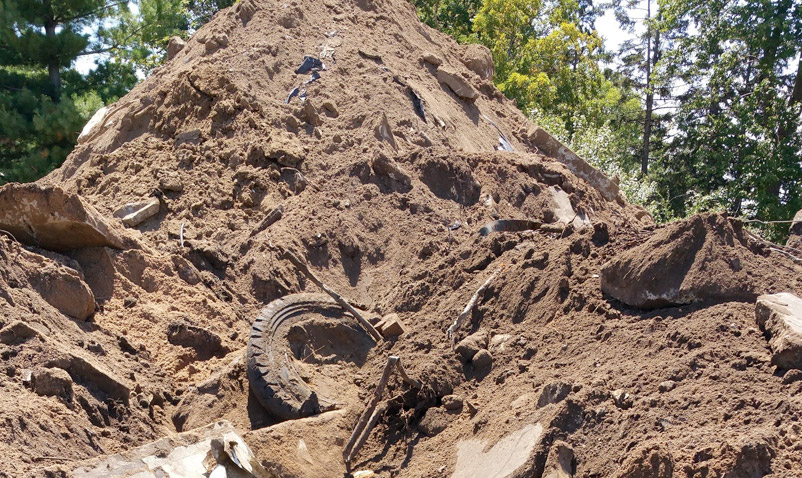- Home
- /
- Services
- /
- Environmental
- /
- Environmental Due Diligence
Environmental Due Diligence
Due Diligence, Environmental Site Assessment, Investigation

Did you realize that you can be held responsible for cleaning up environmental contamination left by a previous property owner or business operator?
Prior to purchasing a property, it is critical that you identify and evaluate environmental risks associated with the current and historical uses of that property. The process of assessing real estate for risks of potential environmental issues, before purchasing it, is known as conducting “environmental due diligence”.
As a seller, it may also be necessary to perform environmental due diligence to satisfy the buyer and/or their lender. For some properties, you may even run into due diligence requirements as part of a refinancing process to protect the financial institution from being held responsible for hidden contamination.
Our Expertise includes both Phase I and Phase II ESA
AET’s Environmental Group has decades of experience performing due diligence services, including environmental site assessments (Phase I ESA) and Transaction Screen Assessments (TSA), site investigations (Phase II ESA), asbestos and hazardous material and regulated waste surveys, and remediation design services. We assist clients in evaluating the environmental risks before they purchase or refinance a property.
Our seasoned professionals, will help you understand the issues and we’ll complete the due diligence process in a timely and cost-effective manner.
AET environmental professionals have assisted with due diligence on thousands of real estate transactions, from simple refinancing of small properties to complex redevelopment of state and federal superfund projects. Our professionals have also performed due diligence on transportation corridor projects ranging from less than a mile to 10’s of miles. AET will tailor our services to meet the scope and the complexity of your project — to reach an acceptable and safe level of risk for the transaction.
How we work: a dedicated environmental professional who’s on your side
At AET you will have a single point of contact in our environmental group who will keep you informed during each step of the project, including timely budget updates. AET will not give unexpected results the day before closing or last-minute requests for change orders to complete our work.
AET provides a full range of site assessment and site investigation services
Transaction Screen Assessment (TSA)
For lower-risk sites, typically consisting of vacant property with no significant historical uses, sometimes a limited review consisting of a site visit, review of regulatory databases, completion of a user questionnaire and review of the property use history is preferred, rather than the completion of a full Phase I ESA. AET environmental professionals have completed 100s of TSAs over the last three decades. This limited review is referred to as a Transaction Screen Assessment (TSA). The completion of a TSA does not qualify a purchaser for Landowner Liability Protections under the Federal Comprehensive Environmental Response, Compensation and Liability Act (CERCLA), however, these protections may not be necessary, given the current state and history of the property.
Phase I Environmental Site Assessments
Environmental Site Assessments (ESA) are integral to real estate transactions and property developments. ESAs are important to help avert the purchase of a significant environmental problem, avoid redevelopment project delays, and generally minimize risk.
AET’s environmental professionals can help identify and resolve potential environmental issues associated with a property. Different magnitudes and scopes of due diligence services may be warranted, depending on the property size, location, property use history, type of property and future intended uses.
The length of the Phase I-II process depends on the size and complexity of the property history. Smaller, one-parcel transactions associated with vacant properties will typically take 2-3 weeks to complete. Large transportation projects will sometimes require months to complete the Phase I and Phase II portions.
Generally, during a Phase I ESA, we review existing records and online resources and conduct an onsite visit to identify potential soil, soil vapor and groundwater contamination that could have been caused from current or historical activities, on, or adjacent to, the property. Suspected or confirmed contamination identified during the Phase I ESA is referred to as a “recognized environmental condition” (REC). Generally, identifying a REC means that a Phase II ESA will be needed.
Phase I ESAs are conducted in strict accordance with the current ASTM standard, E1527-13 (which is currently under revision and is expected to be published in 2021). Phase I ESAs are also prepared to meet the requirements of the USEPA’s “All Appropriated Inquiries” (AAI) rules. Only when a Phase I ESA to prepared according to these standards, is the “User” of the Phase I ESA eligible for Landowner Liability Protections (LLPs).
Public agencies (i.e. departments of transportation), lenders, and some private organizations also include additional requirements above and beyond ASTM 1527 and EPA’s AAI rule. AET is familiar with Small Business Administration (SBA) SOP 50 10 6 requirements, and also Fannie Mae and Freddie Mac compliance guidance.
Phase II Environmental Site Assessments
In order to complete environmental due diligence during a transaction, sometimes it is necessary to conduct Phase II ESAs to confirm the presence, or lack of, “recognized environmental conditions” (RECs) identified during the Phase I ESA.
Some RECs that may warrant a Phase II ESA include:
- History of industrial activity on or adjacent to the property, including the use, storage and disposal of hazardous materials or petroleum products (dry cleaners, gas stations, etc.)
- The presence of underground and above ground storage tanks
- Un-explained distressed vegetation or stained soils
- Presence of on-site floor drains or flammable waste traps
- Aerial photographs indicating on-site filling activities
In order to properly evaluate RECs identified in the Phase I ESA, Phase II assessments typically include the collection and analysis of samples of soil, groundwater, and soil vapor. These samples are collected from onsite soil borings, monitoring wells, and test pits.
When construction is planned for the property, AET often works in conjunction with the AET Geotechnical Group to combine environmental and geotechnical subsurface investigations, in an effort to save clients’ money and time.
Phase II documentation involves the preparation of a report that includes a discussion of investigation methods and results, along with conclusions and recommendations regarding whether or not any additional investigation is needed or if, through the investigation, the RECs have been eliminated.
Surveys for Asbestos, hazardous materials, and regulated wastes
When there are plans to remodel or demolish structures on a property, several states require the identification and removal of asbestos and hazardous materials prior to demolition. AET conducts surveys to identify the presence of asbestos-containing materials (ACM), hazardous materials such as lead paint, special wastes such as mercury switches and fluorescent light bulbs, and mold. AET has conducted ACM and hazardous materials surveys for numerous property types, including small, single-story structures, multi-story residential buildings, and commercial buildings, and for properties to be acquired within transportation project corridors.
Remediation Services
If contamination requires mitigation or remediation, AET can provide guidance on alternative approaches and solutions. AET has extensive experience with environmental remediation planning, coordination, and implementation.
If needed, we can provide soil vapor investigation and vapor mitigation services, consistent with current Vapor Intrusion Best Management Practices guidance and/or ASTM guidance
To help with cleanup and remediation funding, AET can also assist with pursuing cleanup grants, State Petrofund and Dry Cleaner Fund reimbursement programs, and other available grants.
Contact an Environmental Professional
Related Services
Environmental Projects

We are excited to announce the addition of David Koppel to Team AET as our new Environmental Manager in the …

AET is part of team working to assess the current condition and determine the remaining service life of a landmark …